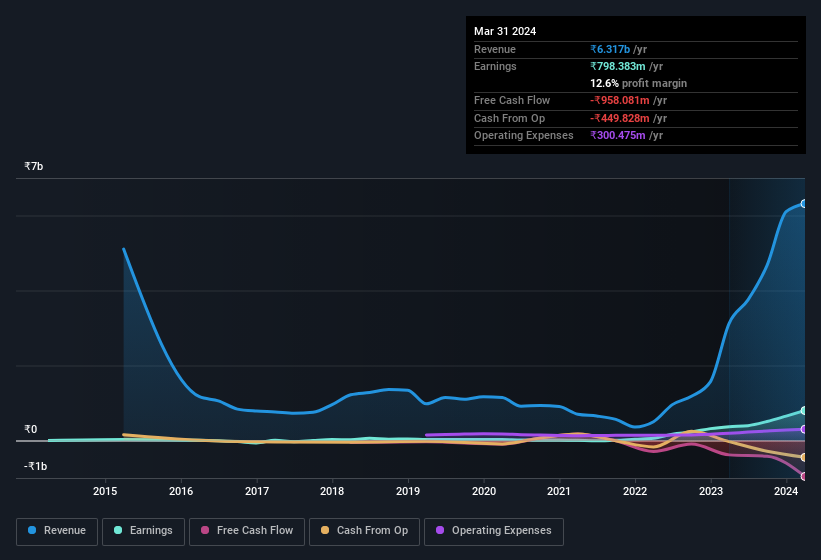Why Lloyds Engineering Works' (NSE:LLOYDSENGG) Healthy Earnings Aren’t As Good As They Seem

Investors appear disappointed with Lloyds Engineering Works Limited's (NSE:LLOYDSENGG) recent earnings, despite the decent statutory profit number. We did some digging and found some worrying factors that they might be paying attention to.
View our latest analysis for Lloyds Engineering Works

A Closer Look At Lloyds Engineering Works' Earnings
As finance nerds would already know, the accrual ratio from cashflow is a key measure for assessing how well a company's free cash flow (FCF) matches its profit. To get the accrual ratio we first subtract FCF from profit for a period, and then divide that number by the average operating assets for the period. You could think of the accrual ratio from cashflow as the 'non-FCF profit ratio'.
That means a negative accrual ratio is a good thing, because it shows that the company is bringing in more free cash flow than its profit would suggest. While it's not a problem to have a positive accrual ratio, indicating a certain level of non-cash profits, a high accrual ratio is arguably a bad thing, because it indicates paper profits are not matched by cash flow. Notably, there is some academic evidence that suggests that a high accrual ratio is a bad sign for near-term profits, generally speaking.
Over the twelve months to March 2024, Lloyds Engineering Works recorded an accrual ratio of 0.61. Statistically speaking, that's a real negative for future earnings. And indeed, during the period the company didn't produce any free cash flow whatsoever. In the last twelve months it actually had negative free cash flow, with an outflow of ₹958m despite its profit of ₹798.4m, mentioned above. We also note that Lloyds Engineering Works' free cash flow was actually negative last year as well, so we could understand if shareholders were bothered by its outflow of ₹958m. Unfortunately for shareholders, the company has also been issuing new shares, diluting their share of future earnings.
Note: we always recommend investors check balance sheet strength. Click here to be taken to our balance sheet analysis of Lloyds Engineering Works.
In order to understand the potential for per share returns, it is essential to consider how much a company is diluting shareholders. As it happens, Lloyds Engineering Works issued 9.4% more new shares over the last year. Therefore, each share now receives a smaller portion of profit. Per share metrics like EPS help us understand how much actual shareholders are benefitting from the company's profits, while the net income level gives us a better view of the company's absolute size. You can see a chart of Lloyds Engineering Works' EPS by clicking here.
How Is Dilution Impacting Lloyds Engineering Works' Earnings Per Share (EPS)?
Lloyds Engineering Works has improved its profit over the last three years, with an annualized gain of 15,750% in that time. But EPS was only up 13,105% per year, in the exact same period. And the 117% profit boost in the last year certainly seems impressive at first glance. But in comparison, EPS only increased by 96% over the same period. So you can see that the dilution has had a bit of an impact on shareholders.
In the long term, earnings per share growth should beget share price growth. So it will certainly be a positive for shareholders if Lloyds Engineering Works can grow EPS persistently. But on the other hand, we'd be far less excited to learn profit (but not EPS) was improving. For that reason, you could say that EPS is more important that net income in the long run, assuming the goal is to assess whether a company's share price might grow.
Our Take On Lloyds Engineering Works' Profit Performance
In conclusion, Lloyds Engineering Works has weak cashflow relative to earnings, which indicates lower quality earnings, and the dilution means its earnings per share growth is weaker than its profit growth. Considering all this we'd argue Lloyds Engineering Works' profits probably give an overly generous impression of its sustainable level of profitability. Keep in mind, when it comes to analysing a stock it's worth noting the risks involved. To that end, you should learn about the 3 warning signs we've spotted with Lloyds Engineering Works (including 2 which are concerning).
Our examination of Lloyds Engineering Works has focussed on certain factors that can make its earnings look better than they are. And, on that basis, we are somewhat skeptical. But there are plenty of other ways to inform your opinion of a company. Some people consider a high return on equity to be a good sign of a quality business. While it might take a little research on your behalf, you may find this free collection of companies boasting high return on equity, or this list of stocks that insiders are buying to be useful.
New: AI Stock Screener & Alerts
Our new AI Stock Screener scans the market every day to uncover opportunities.
• Dividend Powerhouses (3%+ Yield)
• Undervalued Small Caps with Insider Buying
• High growth Tech and AI Companies
Or build your own from over 50 metrics.
Have feedback on this article? Concerned about the content? Get in touch with us directly. Alternatively, email editorial-team (at) simplywallst.com.
This article by Simply Wall St is general in nature. We provide commentary based on historical data and analyst forecasts only using an unbiased methodology and our articles are not intended to be financial advice. It does not constitute a recommendation to buy or sell any stock, and does not take account of your objectives, or your financial situation. We aim to bring you long-term focused analysis driven by fundamental data. Note that our analysis may not factor in the latest price-sensitive company announcements or qualitative material. Simply Wall St has no position in any stocks mentioned.
About NSEI:LLOYDSENGG
Lloyds Engineering Works
Provides engineering products and services in India.
Excellent balance sheet with acceptable track record.
Similar Companies
Market Insights
Community Narratives



